#Canadian serviceberry
Photo

Blue Jay on Shadbush
#bird#blue jay#jay#shadbush#flowers#illustration#drawing#jada fitch#natural#Cyanocitta cristata#wildlife#illustation#art#design#pen and ink#serviceberry#Amelanchier canadensis#Canadian serviceberry#chuckle-berry#currant-tree#blue
518 notes
·
View notes
Video
n462_w1150 by Biodiversity Heritage Library
Via Flickr:
Florae Austriacae, sive, Plantarum selectarum in Austriae archiducatu. Viennæ Austriæ :Leopoldi Joannis Kaliwoda,1773-78.. biodiversitylibrary.org/page/278134
#1773#Austria#Botany#Copper engraving#Graphic media :#Hand colored#Missouri Botanical Garden#Peter H. Raven Library#bhl:page=278134#dc:identifier=http://biodiversitylibrary.org/page/278134#flickr#botanical illustration#scientific illustration#MESPILUS AMELANCHIER#Amelanchier canadensis#bilberry#canadian serviceberry#chuckle-berry#currant-tree#juneberry#thicket serviceberry#shadbush serviceberry#shadbush#shad-blow#shad-blow serviceberry
3 notes
·
View notes
Text
Native Plants I’ve Actually Seen Growing Wild in Southern Ontario
Acer saccharinum (silver maple) --along the sides of highways
Acer saccharum (sugar maple) --GTA ravines
Achillea millefolia (yarrow) --GTA ravines
Allium schoenoprasum (wild chives) --GTA ravines, Ridgetown
Allium tricoccum (ramps) --Niagara region escarpments
Amaranthus retroflexus (redroot amaranth) --fallow areas in the GTA
Ambrosia artemisiifolia (ragweed) --fallow areas in the GTA
Ambrosia trifida (giant ragweed) --parks in the GTA
Amelanchier spp. (saskatoon/serviceberry) --GTA ravines
Arisaema triphyllum (Jack-in-the-pulpit) --GTA ravines
Aronia melanocarpa (black chokeberry) --ravines and parks in the GTA
Asarum canadense (Canada ginger) --GTA ravines
Asclepias syriaca (common milkweed) --fallow areas, ravines, and parks throughout southern Ontario from Windsor to GTA
Asplenium trichomanes (maidenhair spleenwort) --Niagara region escarpments
Betula spp. (birch) --ravines and parks throughout southern Ontario from Windsor to GTA
Bidens spp. (beggar ticks) --GTA ravines
Caulophyllum thalictroides (blue cohosh) --GTA parks
Ceratophyllum demersum (hornwort) --GTA ravines (native in freshwater across the globe anyway)
Circaea lutetiana (enchanter’s nightshade) --fallow areas in the GTA
Commelina spp. (dayflower) --fallow areas in Windsor
Cornus alternifolia (Pagoda dogwood) --GTA wooded areas
Cornus sericea (red osier dogwood) --GTA ravines and in Windsor riverside parks
Crataegus spp. (hawthorn) --GTA ravines and parks
Echinocystis lobata (wild prickly cucumber) --GTA ravines
Elaeagnus commutata (silverberry) --GTA parks and fallow areas
Epilobium ciliatum (fringed willowherb) --fallow areas in the GTA
Equisetum spp. (horsetail/scouring rush) --GTA ravines and fallow areas
Erigeron spp. (fleabane) --GTA parks and fallow areas, Ridgetown
Erythronium americanum (trout lily) --GTA ravines and parks
Eutrochium maculatum (Joe-Pye weed) --GTA parks
Fragaria virginiana (wild strawberry) --fallow areas in the GTA
Geranium maculatum (wild geranium) --Windsor green spaces
Geranium robertianum (herb robert) --Windsor green spaces
Geum aleppicum (yellow avens) --GTA fallow areas
Geum canadense (white avens) --GTA fallow areas
Geum macrophyllum (large-leaved avens) --GTA fallow areas
Gymnocladus dioicus (Kentucky coffee tree) --GTA ravines
Helianthus spp. (sunflower) --GTA fallow areas and parks
Heracleum maximum (cow parsnip) --GTA ravines
Hordeum jubatum (foxtail barley) --GTA fallow areas
Humulus lupulus (hops) --GTA ravines
Hydrophyllum virginianum (Virginia waterleaf) --GTA ravines
Impatiens capensis (jewelweed) --GTA ravines and in Windsor riverside parks
Juglans nigra (black walnut) --GTA ravines
Lactuca canadensis (Canadian lettuce) --GTA fallow areas
Lilium michiganense (Michigan lily) --GTA ravines
Lupinus perennis (sundial lupine) --GTA parks
Maianthemum canadense (Canada mayflower) --GTA ravines
Maianthemum racemosum (starry false solomon’s seal) --GTA ravines and parks
Maianthemum stellatum (starry false solomon’s seal) --GTA ravines
Matteuccia struthiopteris (ostrich fern) --GTA ravines
Monarda fistulosa (wild bergamot) --GTA ravines and parks
Morus rubra (red mulberry) --fallow areas in Windsor, GTA parks
Myosotis laxa (smallflower forget-me-not) --GTA fallow areas
Oenothera biennis (evening primrose) --GTA fallow areas
Onoclea sensibilis (sensitive fern) --GTA ravines
Oxalis stricta (yellow wood sorrel) --fallow areas and ravines throughout southern Ontario from Windsor to GTA
Parietaria pensylvanica (Pennsylvania pellitory) --GTA fallow areas
Parthenocissus quinquefolia (Virginia creeper) --Windsor fallow areas and GTA ravines and parks
Persicaria lapathifolia (curlytop smartweed) --GTA fallow areas
Podophyllum peltatum (mayapple) --GTA ravines and parks
Portulaca oleracea (purslane) --fallow areas throughout southern Ontario from Windsor to GTA (native globally anyway)
Potentilla norvejica monspeliensis (ternate-leaved cinquefoil) --GTA fallow areas
Prunella vulgaris (selfheal) --fallow areas and ravines throughout southern Ontario from Windsor to GTA
Prunus virginiana (chokecherry) --Windsor fallow areas, GTA ravines and parks, Niagara region escarpments
Pteridium aquilinum latiusculum (western bracken fern) --GTA parks
Quercus spp. (oak) --wooded areas throughout southern Ontario from Windsor to GTA
Rhus typhina (staghorn sumac) --parks and fallow areas throughout southern Ontario from Windsor to Collingwood
Ribes spp. (currants) --GTA ravines and parks
Ribes spp. (gooseberries) --GTA ravines
Robinia pseudoacacia (black locust) --GTA ravines and parks
Rosa spp. (roses) --GTA ravines, parks, and fallow areas
Rubus occidentalis (black raspberry) --ravines, parks, and fallow areas in Hamilton and GTA
Rubus odoratus (purple-flowered raspberry) --GTA ravines and parks
Rubus strigosus (American red raspberry) --GTA parks
Rudbeckia hirta (black-eyed susan) --GTA parks
Salix spp. (willow) --GTA ravines
Sambucus canadensis (common elderberry) --Windsor riverside parks, GTA ravines
Sambucus racemosa (red elderberry) --GTA ravines and parks
Smilax spp. (greenbrier) --GTA parks
Solidago canadensis (Canada goldenrod) --parks and fallow areas throughout southern Ontario from Windsor to GTA
Sorbus spp. (mountain ash) --GTA ravines and parks
Streptopus spp. (twistedstalk) --GTA parks
Symphoricarpos spp. (snowberry) --GTA parks
Symphyotrichum ericoides (heath aster) --fallow areas throughout southern Ontario from Windsor to GTA
Symphyotrichum novae-angliae (New England aster) --fallow areas throughout southern Ontario from Windsor to GTA
Symplocarpus foetidus (skunk cabbage) --GTA parks
Tilia spp. (linden) --GTA ravines
Trillium grandiflorum (white trillium) --parks throughout southern Ontario from Windsor to GTA
Tsuga canadensis (eastern hemlock) --GTA parks
Typha latifolia (broad-leaved cattail) --marshes in Essex county and GTA
Urtica gracilis (slender nettle) --GTA ravines
Uvularia spp. (bellwort) --streams in Windsor green spaces
Verbena hastata (blue vervain) --GTA ravines
Viburnum lentago (nannyberry) --GTA parks and Ridgetown ravine
Viburnum trilobum (highbush cranberry) --Ridgetown
Viola sororia (wood violet) --fallow areas and wooded areas throughout southern Ontario from Windsor to GTA
Vitis riparia (riverbank grape) --GTA fallow areas, ravines, and parks
Waldsteinia fragarioides (barren strawberry) --GTA ravines and parks
Xanthium strumarium canadense (Canada cocklebur) --GTA parks and fallow areas
I’ve likely seen many others and just couldn’t identify them, but there are a lot I’ve never seen growing wild. What I’m hoping is that some of the native species I have in my garden will make their way to the nearby ravine. If I get around to it, though, I might just take a walk with some Asclepias incarnata (swamp milkweed) seeds in the fall. They certainly seem to successfully germinate in my garden whether I want them to or not (don’t have space for them to go crazy). Can’t see why they wouldn’t in a natural swamp area.
#text post#long text post#native plants of Ontario#native plants of North America#wild native plants
10 notes
·
View notes
Photo

Yellow Warbler (Setophaga petechia) in a Blooming Shadbush (Amelanchier canadensis).
#Setophaga petechia#yellow warbler#Dendroica petechia#bird#flowers#shadbush#serviceberry#Amelanchier canadensis#bilberry#Canadian serviceberry#chuckle-berry#currant-tree#juneberry#thicket serviceberry#sugarplum#shad-blow#maine#spring migration#jada fitch#bird photography#yellow#white flowers#maine birds#YEWA
664 notes
·
View notes
Photo


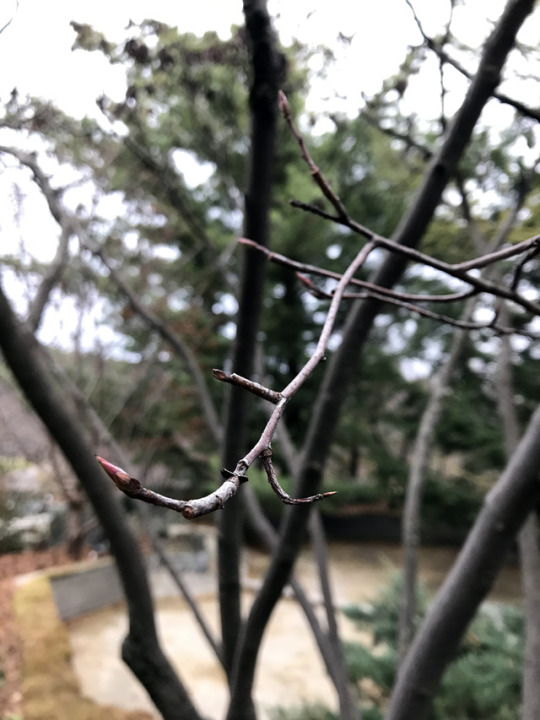

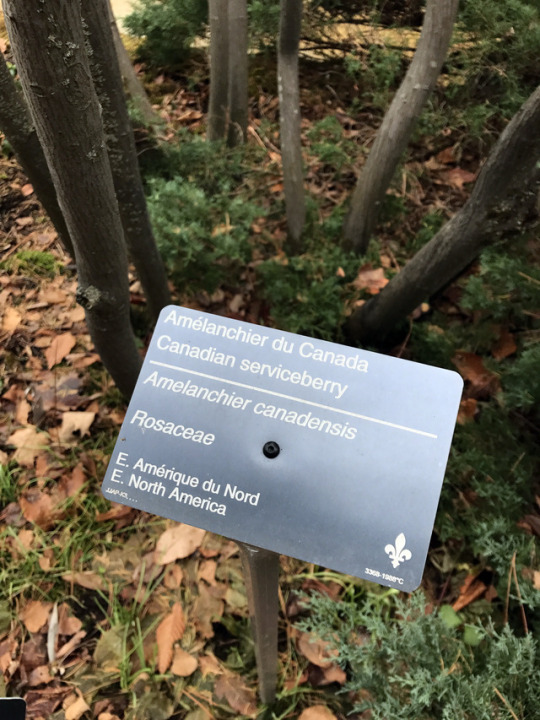
Amelanchier canadensis / Canadian Serviceberry
PLANT COMMUNITY: New England barrier beach
NATIVE REGION: Eastern North America, from Maine to Georgia, west to Mississippi and in eastern parts of Tennessee
MATURE SIZE: Height of 25-30′, spread of 15-20′; large shrub or small tree
HABITAT/GROWING CONDITIONS: Swamps, lowlands, and thickets; easily grown in average, medium, well-drained soil in full sun to part shade; tolerant of a somewhat wide range of soils
ECO-INDICATOR: N/A
HARDINESS ZONE: 4-8
LEAF COLOR: Finely toothed, elliptic, medium to dark green leaves, change to orange-red in autumn.
FLOWER COLOR: Showy, five-petaled, slightly fragrant white flowers drooping clusters
FRUIT COLOR: Small, round, green berries, turn red and mature to a dark purplish-black in early summer
VALUE FOR REHABILITATION OF DISTURBED SITES: Serviceberry is useful as a windbreak planting.
SOURCES: https://plants.usda.gov/plantguide/pdf/pg_amca4.pdf; http://www.missouribotanicalgarden.org/PlantFinder/PlantFinderDetails.aspx?kempercode=j290; https://www.extension.umn.edu/environment/agroforestry/selecting-trees-shrubs-windbreaks/docs/windbreaksrevised_1.pdf
#amelanchier canadensis#canadian serviceberry#barrier beach#eastern north america#north america#eastern us#canada#swamps#thickets#lowlands#zone 4#zone 5#zone 6#zone 7#zone 8
15 notes
·
View notes
Photo


For today’s shop update, a throwback with a new twist!
As some of you may recall I used to make these large versions of my stainless steel capped, bullet-shaped pendants. I stopped for a few reasons, but the final reason being that when I re-made the mold master for them, I inadvertently made them slightly too fat to fit into the old stainless steel bead caps I used, and after months couldn’t find caps that would properly fit them.
Thus, the several that I made sat in storage on my shelf for a year or more, in limbo. That was until I did some workshop cleaning a few weeks ago, rediscovered this old stash of half finished pendants, and realized, in lieu of the stainless steel caps, I could at least finish them off with an improvised electroplated top, which is exactly what I did!
I have 12 new large bullet shaped electroplated pendants, featuring a wide variety of plants, including Christmas Fern fiddleheads, Canadian Serviceberry, Feverfew, Yarrow, Wormwood, Wild Carrot, Red Clover, Hyssop, Golden Alexander, and Buttercup.
Because these are over a year old, some of the vividness of the pigments in the plants has understandably faded to a warm, desaturated, antique hue, but the finish on the pendants is crystal clear.
Bear in mind, this may be the last time I ever make these pendants, so grab them if you like them!
The update will be at 3:30 EST today, Sunday February 28th!
Moss of the Woods Store
86 notes
·
View notes
Text
got seeds coming now for
Canadian Serviceberry (Amelanchier canadensis), Allegheny Serviceberry (Amelanchier laevis), a new heirloom Seaberry (Hippophae rhamnoides) variety to cross with my current one, Sochan (Rudbeckia laciniata), and Virginia Waterleaf (Hydrophyllum virginianum)
During my second year (last year) of starting seeds in an outdoor nursery-like environment I did enough different things that I feel I’ve a significantly better understanding of how to propagate a variety of woody perennials from seed
I’m excited to add these foods to the little suburban food forest system.. Now that I also have Hopniss (Apios americana) successfully growing there and a variety of edible plants coming up on their own, it feels like it’s getting closer to the point when it will become more about harvesting biomass than about inputs. So far this year I haven’t had to water anything except new plantings for a day or two after planting. but I have also let things grow in much more thickly than previous years so the soil is not exposed at all, from the combination of groundcover plants and compost/mulch on the surface.
6 notes
·
View notes
Photo

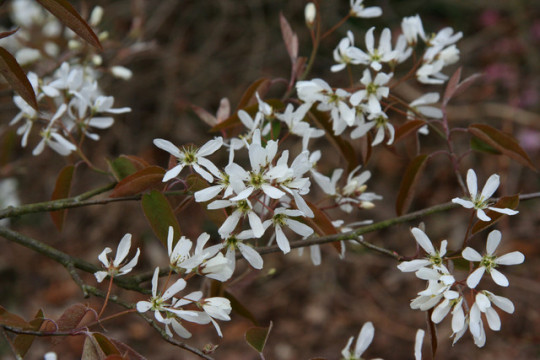
Daily Tree: amelanchier canadensis
In English please: Bilberry, Canadian Serviceberry, Chuckleberry, Currant-Tree, ,Juneberry, Shadblow Serviceberry, Shadblow, Shadbush, Shadbush Sherviceberry, Sugarplum, Thicket Serviceberry
Grows: Atlantic Coast, from Maine down to Alabama
Wikipedia page: here
Photo 1: https : // nurcar . com/products/amelanchier-canadensis
Photo 2: https : // www . rhs . org . uk/Plants/1063/Amelanchier-canadensis-(L-)-Medik/Details
39 notes
·
View notes
Photo



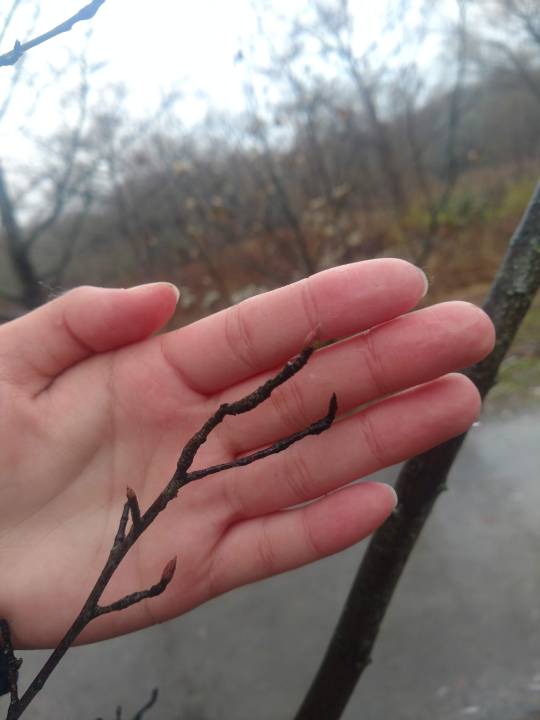



Thicket (Canadian) Serviceberry • Amelanchier canadensis
Plant Community: Barrier Beach
Native Status: Native to Eastern North America
Mature Size (h, w): 25-30 ft, 15-20 ft
Habitat/Preferred Conditions: Full sun to partial shade. Prefers medium well drained soils. Semi-tolerant of a range of soil.
Eco-indicator: N/A
Hardiness zone: 4-8
Leaf Color: Green (Summer), Orange/Red (Fall)
Flower Color: White
Bloom Time: April-May
Theme:
The Canadian Serviceberry serves a numerous amount of pollinators. First, and likely of the most vital importance, it is host to several varieties of butterflies. Firstly, there is the Red-Spotted Purple, also known as “Limenitis Arthemis.”

https://www.butterfliesandmoths.org/species/Limenitis-arthemis-astyanax
Secondly, the tree also hosts the Viceroy butterfly or “Limenitis archippus”.

https://en.wikipedia.org/wiki/Viceroy_%28butterfly%29
The Tiger Swallowtail “Papilio glaucus” and the

http://www.pottcoconservation.com/blog/?p=2046
Admiral Butterfly “Vanessa atalanta” also rely on the Canadian Serviceberry.

Lastly, this tree is also an important host to the Striped Hairstreak “Satyrium liparops”.

http://wisconsinbutterflies.org/butterfly/species/38-striped-hairstreak
The Canadian Service berry is early-blooming tree, making it a vital resource for insect pollinators, specifically bees and butterflies, form whom it represents a crucial food and pollen source.
Furthermore, the tree also produces small fruits that are popular with both birds and mammalian pollinators. Birds which consume the fruit include robins, woodpeckers, thrushes, and orioles. Squirrels and chipmunks also consume the fruit.
This tree is largely undisturbed by deer.
Sources:
http://www.missouribotanicalgarden.org/PlantFinder/PlantFinderDetails.aspx?taxonid=286376&isprofile=1&basic=amelanchier%20canadensis
https://plants.usda.gov/core/profile?symbol=AMCA4
https://plants.usda.gov/plantguide/pdf/pg_amca4.pdf
https://plants.ces.ncsu.edu/plants/amelanchier-canadensis/
#vertical: understory#place: arnold#community: barrier#pollinator: insect#pollinator: bird#pollinator: mammal#pollinator: butterfly#pollinator: bee#pollinator: thrush#pollinator: robin#pollinator: woodpecker#pollinator: squirrel#pollinator: chipmunk
0 notes
Video
n380_w1150 by Biodiversity Heritage Library
Via Flickr:
A guide to the wild flowers.. New York,F. A. Stokes[1899]. biodiversitylibrary.org/page/40764791
#United States#Wild flowers#New York Botanical Garden#LuEsther T. Mertz Library#bhl:page=40764791#dc:identifier=https://biodiversitylibrary.org/page/40764791#artist:name=Marian Ellis Rowan#Merian Ellis Rowan#HerNaturalHistory#Taxonomy:binomial=Amelanchier canadensis#Taxonomy:common=Canadian serviceberry#Taxonomy:family=Rosaceae#Taxonomy:common=Shad-bush#Serviceberry#WomenInScience#flickr#amelanchier canadensis#bilberry#canadian serviceberry#chuckle-berry#currant-tree#juneberry#shad-blow serviceberry#shad-blow#shadbush#shadbush serviceberry#sugarplum#thicket serviceberry
0 notes
Text
How To Grow Saskatoon Shrubs In The Garden
How To Grow Saskatoon Shrubs In The Garden
[ad_1]

What is a Saskatoon bush? Also known as juneberry, prairie berry or serviceberry, the Saskatoon bush (Amelanchier alnifolia) originates from the region extending from the interior of the land, from the northwest and the Canadian Prairies to the southern Yukon. Saskatoon shrubs are attractive plants that bloom in the spring and produce heaps of purple-blue Saskatoon berries in summer.
Sas…
View On WordPress
0 notes
Text
Dug out one of the areas the Canada goldenrod had planted itself in, which is a very bad spot for such an aggressive plant. Ended up with like an armload of rhizomes. Took one piece and transplanted it to the area I had initially planned for that species, but the one I ordered ended up being an aster of unknown species. I cut the shoots off the rest and will be eating them. Still have to grab the rest growing in the other area. Got all the weeds and garbage out of the front, and cut off and chopped of the dead bits. These will disappear as birds and squirrels take them to build their nests, but for now it’s a natural mulch. I didn’t have time for the side or the back, but I’ll do the side at least tomorrow. I did however take look through to see what’s coming up!
And so far, of the 172 plants I have planted (and I have 72 more on the way, starting mid-May!), the following are showing signs of life or even leafing out:
*EDITED TO ADD THOSE I NOTICED TODAY (DAY AFTER POSTING)*
001. Achillea millefolium (yarrow) 3rd year!
002. Adiantum pedatum (maidenhair fern) Survived its first winter into 2nd year!
003. Agastache foeniculum (anise hyssop) 4th year!
004. Agastache scrophulariifolia (purple giant hyssop) Survived its first winter into 2nd year!
005. Allium canadense (Canada garlic) 5th year!
006. Allium cernuum (nodding onion) 5th year!
007. Allium schoenoprasum (chives) 4th year!
008. Allium stellatum (pink onion) Survived its first winter into 2nd year!
009. Allium tricoccum (ramps) 3rd year!
010. Amelanchier canadensis (Canadian serviceberry) 4th year! But still too young for fruit.
011. Anaphalis margaritacea (pearly everlasting) 5th year!
012. Andromeda polifolia (bog rosemary) Survived its first winter into 2nd year!
013. Aquilegia brevistyla (smallflower columbine) 4th year!
014. Aquilegia canadensis (eastern red columbine) 5th year!
015. Arabis alpina (alpine rockcress) Survived its first winter into 2nd year! The first one I attempted was extremely root-bound coming out the pot and sadly did not survive the winter, but this one did!
016. Argentina anserina (silverweed) Survived its first winter into 2nd year!
017. Armeria maritima (Thrift seapink) 3rd year!
018. Aronia melanocarpa (black chokeberry) 3rd year! But still too young for fruit.
019. Artemisia ludoviciana (white sage) 3rd year! It was supposed to be A. frigida, but...it’s not. lol Thankfully it’s not too aggressive so far.
020. Aruncus dioicus (bride’s feathers) 3rd year!
021. Asarum canadense (Canada ginger) 4th year!
022. Asclepias incarnata (swamp milkweed) 4th year!
023. Asclepias sullivanti (prairie milkweed) Survived its first winter into 2nd year!
024. Asclepias syriaca (common milkweed) 3rd year!
025. Asimina triloba (pawpaw) 5th year! But still too young for fruit.
026. Asplenium trichomanes (maidenhair spleenwort) 3rd year!
027. Athyrium felix-femina (lady fern) 3rd year!
028. Caltha palustris (marsh marigold) 3rd year!
029. Campanula rotundifolia (harebell) 5th year!
030. Cardamine concenata (cutleaf toothwort) Came out of dormancy for it’s 1st year!
031. Castilleja miniata (giant red paintbrush) Survived its first winter into 2nd year! It’s a parasitic plant, so I planted it at the stone line so it could feed off the grass, and close to the sunchokes so it can feed off them too, plus there are cedar roots from the trees by the well, and I’ve just transplanted Canada goldenrod nearby so I think it will be okay!
032. Ceanothus americanus (New Jersey tea) 3rd year!
033. Cerastium arvense (field chickweed) 4th year!
034. Cercis canadensis (eastern redbud) 4th year! But still too young for flowers.
035. Clinopodium arkansanum (wild savoury) Survived its first winter into 2nd year!
036. Comptonia peregrina (Sweetfern) Survived its first winter into 2nd year!
037. Coreopsis lanceolata (lance-leaved tickseed) 3rd year!
038. Cornus canadensis (bunchberry) Survived its first winter into 2nd year! The squirrels did not dig it up this time!
039. Cornus florida (flowering dogwood) 3rd year! But still too young for flowers.
040. Cystopteris bulbifera (berry bladder fern) 3rd year!
041. Dalea purpurea (purple prairie clover)
042. Drymocallis arguta (prairie cinquefoil) Survived its first winter into 2nd year!
043. Echinacea purpurea (purple coneflower) 5th year!
044. Erigeron glabellus var. pubescens (streamside fleabane) Survived its first winter into 2nd year! I put it in a very narrow ugly side area. Should help to pretty it up along with black-eyed susan and whatever else I think will go nicely there.
045. Erythronium americanum (trout lily) 3rd year! And not only that but despite not flowering and my not seeing any dropper stems last year, the thing has somehow spread itself. I have no idea how I missed the number of droppers that would have been necessary to make this happen but I’m not complaining. Be nice if one of them flowered this year though.
046. Eupatorium purpureum (sweet Joe Pye weed) Survived its first winter into 2nd year!
047. Fragaria vesca (woodland strawberry) 3rd year! Mine has white strawberries. Apparently that can happen with this species. Still taste like strawberries. I hope it makes lots this year.
048. Fragaria virginiana (Virginia strawberry) 3rd year! Would be awesome if it made more than flowers this year though.
049. Galium boreale (northern bedstraw) Survived its first winter into 2nd year! My first attempt died. Probably because it was potted too long and planted too late.
050. Gaultheria procumbens (American wintergreen) 4th year! It’s not doing the greatest, likely due to how root-bound it was when I got it, but it’s been hanging on. I’m getting it a friend this year, so hopefully that will help.
051. Geranium maculatum (wild geranium) 4th year!
052. Geranium robertianum (herb Robert) Survived its first winter into 2nd year!
053. Geum aleppicum (yellow avens) 4th year at least! I don’t know for sure, because it was already here when I moved in. It’s native so it gets to stay.
054. Geum canadense (white avens) 4th year at least! I don’t know for sure, because it was already here when I moved in. It’s native so it gets to stay.
055. Geum rivale (purple avens) Survived its first winter into 2nd year!
056. Geum triflorum (prairie smoke) 5th year!
057. Grindelia squarrosa (curly cup gumweed) Survived its first winter into 2nd year!
058. Helianthus nuttallii (common tall sunflower) 4th year!
059. Heliopsis helianthoides (false sunflower) 3rd year!
060. Heuchera richardsonii (prairie alumroot) Survived its first winter into 2nd year!
061. Hibiscus moscheutos (swamp rose mallow) 4th year! And coming up early this year, too!
062. Hierochloe odorata (sweetgrass) 5th year! It flowered two years ago. I hope it does again this year.
063. Humulus lupulus (Hop) 3rd year! The current shoots are likely to die though Last year I swear they died five times before it finally took off but eventually it did and had a whole growing year. I expect the same this year.
064. Hydrophyllum virginianum (Virginia waterleaf) Survived its first winter into 2nd year!
065. Juglans nigra (black walnut) Likely somewhere around 150 years old, judging by the size. I obviously didn’t plant it, but it is on the property so it’s mine while I live here.
066. Juniperus horizontalis (creeping juniper) Survived its first winter into 2nd year!
067. Liatris spicata (dense blazing star) Survived its first winter into 2nd year!
068. Lilium michiganense (Michigan lily) 4th year!
069. Lindera benzoin (spicebush) 5th year and flowering!
070. Linum lewisii (blue flax) Survived its first winter into 2nd year!
071. Lysimachia ciliolata (fringed loosestrife) Survived its first winter into 2nd year!
072. Mahonia repens (creeping Oregon grape) 3rd year!
073. Maianthemum stellata (starry false Solomon’s seal) 3rd year!
074. Mentha arvensis (wild mint) 4th year!
075. Menyanthes trifoliata (bog bean) Survived its first winter into 2nd year!
076. Mertensia paniculata (tall bluebells) 4th year!
077. Mertensia virginica (Virginia bluebells) 3rd year!
078. Monarda fistulosa (wild bergamot) 5th year!
079. Monarda punctata (spotted beebalm) 3rd year! And coming in much quicker than last year.
080. Oenothera biennis (evening primrose) Seeded! I had thought my previous plant’s seeds hadn’t taken when no new plants had come up that year, but there are a couple this year close to the area I had it in, so it looks to have successfully reseeded itself after all!
081. Oenothera fruticosa (narrow-leaved sundrops) Survived its first winter into 2nd year! And this species is perennial rather than biennial like its cousin.
082. Oligoneuron rigida (Stiff goldenrod) Survived its first winter into 2nd year!
083. Onoclea sensibilis (Sensitive fern) 3rd year! I’m hoping the meadow sundrops, cup plant, and zigzag goldenrod will help shield it this year. They like part sun/part shade, but the past couple summers were still pretty hard on it.
084. Opuntia fragilis (fragile prickly pear) 4th year! The spring rains are always hard on it, though, and it takes at least a couple weeks in the heat of late spring to recover, so I don’t think it will produce fruit any time soon, certainly not this year.
085. Opuntia humifusa (eastern prickly pear) 3rd year! It did not like this winter though (took the one before it like a champ, though), but it’s showing signs of recovery.
086. Osmundastrum cinnamomea (cinnamon fern) Survived its first winter into 2nd year!
087. Oxalis stricta (yellow wood sorrel) Successfully reseeded! I mean, it basically grows as a weed, so it’s quite prolific. Doesn’t really have an effect on surrounding plants, though, and it’s delicate, so it’s good to have a ton of them if you want to cook desserts or make jams or something with them. They are deliciously tart.
088. Parthenocissus quinquefolia (Virginia creeper) 4th year! Might be older though. It was tiny when I got here (much bigger now!) but I didn’t plant it so I couldn’t judge its years based on size.
089. Phlox divaricata (woodland phlox) 3rd year!
090. Polygonatum biflorum (smooth Solomon’s seal) Survived its first winter into 2nd year!
091. Polystichum acrostichoides (Christmas fern) 3rd year!
092. Prunella vulgaris (common selfheal) I didn’t plant it so I don’t know how long it’s been here. We’ll call it year 5, but it is native and a pretty little thing, with edible and medicinal uses.
093. Prunus nigra (Canada plum) 3rd year! But still too young for fruit.
094. Prunus pumila (sand cherry) Survived its first winter into 2nd year!
095. Prunus serotina (black cherry) 4th year! But still too young for fruit.
096. Pycnanthemum tenuifolium (slender mountain mint) 4th year!
097. Pycnanthemum virginianum (Virginia mountain mint) 4th year!
098. Rhus aromatica (fragrant sumac) 5th year!
099. Rosa blanda (smooth rose) 4th year! Maybe it will bloom this year.
100. Rubus occidentalis (black raspberry) 5th year! This was supposed to be R. strigosus but...I discovered otherwise when the berries turned black instead of remaining red. lol
101. Rubus strigosus (American red raspberry) Survived its first winter into 2nd year! And is hopefully actually R. strigosus this time. lol Pretty sure it’s not R. occidentalis again, though, because it’s much more aggressive.
102. Sambucus canadensis (common elderberry) 5th year! Hopefully this year it makes more berries and they don’t all fall off before turning ripe this time.
103. Silphium perfoliatum (cup plant) Survived its first winter into 2nd year!
104. Sisyrinchium montanum (blue-eyed grass) Survived its first winter into 2nd year!
105. Solidago canadensis (Canada goldenrod) This is its 3rd year since planting itself! We’ll see how it likes the new area I put it in.
106. Solidago flexicaulis (zigzag goldenrod) 3rd year since planting itself!
107. Solidago nemoralis (grey goldenrod) 3rd year!
108. Solidago simplex (spike goldenrod) Survived its first winter into 2nd year! First one I tried died. Maybe wasn’t getting enough sunlight.
109. Spiraea alba (white meadowsweet) 5th year!
110. Sporobolus heterolepis (prairie dropseed) Survived its first winter into 2nd year!
111. Symphoricarpos occidentalis (western snowberry) Survived its first winter into 2nd year!
112. Symphoricarpos orbiculatus (coralberry) Survived its first winter into 2nd year!
113. Symphyotrichum ciliolatum (fringed blue aster) 4th year!
114. Symphyotrichum laeve (smooth aster) 4th year! And spreading where it shouldn’t. Going to try eating the shoots.
115. Symphyotrichum lanceolatum (panicled aster) 4th year! And I’m going to have to do something about those shoots too because that’s getting a little crazy.
116. Symphyotrichum novae-angliae (New England aster) 3rd year!
117. Thalictrum pubescens (tall meadow-rue)
118. Thuja occidentalis (eastern white cedar) Likely around 20 years old or so. There’s a row of them next to a wall. Mine while I live here.
119. Tradescantia ohiensis (Ohio spiderwort) Survived its first winter into 2nd year!
120. Trillium erectum (red trillium) Survived its first winter into 2nd year!
121. Trillium flexipes (nodding wake-robin) 3rd year!
122. Trillium grandiflorum (great white trillium) Survived its first winter into 2nd year!
123. Urtica gracilis (stinging nettle) 4th year since it planted itself in my garden at the old place and I took it with me to the new place!
124. Vaccinium angustifolium (lowbush blueberry) 5th year! Not doing well, though. I have to figure out a different spot for it.
125. Vaccinium corymbosom (northern highbush blueberry) 5th year! Last year I had to transplant it because it did not like the spot it was in. Hopefully it does better in its new home.
126. Verbena hastata (blue vervain) 3rd year!
127. Verbena stricta (hoary vervain) Survived its first winter into 2nd year!
128. Viburnum lentago (nannyberry) 4th year! But still too young for fruit.
129. Viburnum nudum cassinoides (witherod viburnum) 4th year! But still too young for fruit.
130. Viola blanda (sweet white violet) 4th year!
131. Viola canadensis (Canada violet) 4th year!
132. Viola labradorica (Labrador violet) Survived its first winter into 2nd year!
133. Viola nephrophylla (northern bog violet) Survived its first winter into 2nd year!
134. Viola palustris (marsh violet) Survived its first winter into 2nd year!
135. Vitis riparia (riverbank grape) 3rd year!
136. Waldsteinia fragarioides (barren strawberry) Survived its first winter into 2nd year!
137. Zizia aptera (heart-leaved alexanders) Survived its first winter into 2nd year!
138. Zizia aurea (golden alexanders) 4th year!
So most but it’s still early and I wasn’t looking super hard in the side and front areas, so we’ll see how many more will join us this year.
9 notes
·
View notes
Photo

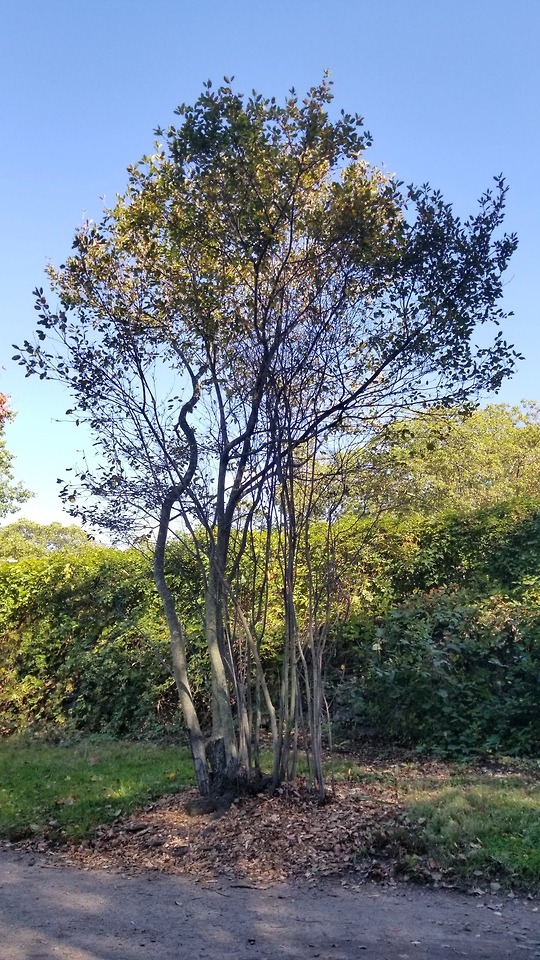


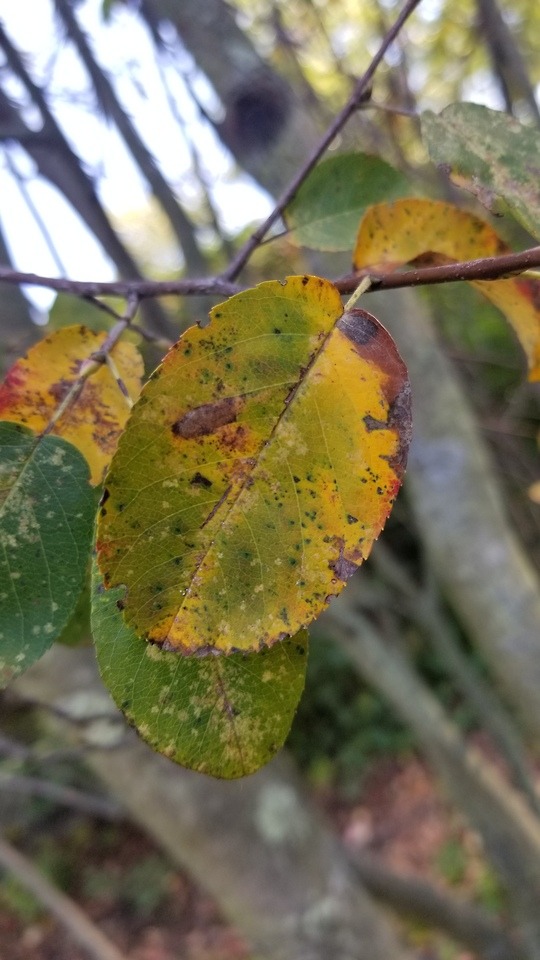


Canadian Serviceberry; Shadblow; Juneberry; Bilberry; Swamp Serviceberry (Amelanchier canadensis)
Mature Size - (6-30′ x 15-20′)
Shape and Form - Shrub or small tree.
Growth Habit - Moderate growth rate. Will form thickets from sucker growth.
Leaves - Finely toothed, elliptic, medium to dark green leaves (1-3" long) change to a variety of orange-red to gold in autumn
Flowers - Features showy, 5-petaled, slightly fragrant, white flowers in drooping clusters which appear before the leaves emerge in early spring. One of the earliest blooming trees in spring.
Fruit/Seeds - Flowers give way to small, round, green berries which turn red and finally mature to a dark purplish-black in early summer. Edible berries resemble blueberries in size and color and are used in jams, jellies and pies.
Bark - Gray-silver, striped bark.
Region - USA native. Native to eastern North American coast, from Quebec to Georgia.
Hardiness Zones - (4-8)
Habitat/Growing Conditions - An understory tree, often found growing in clumps in swamps, lowlands, and thickets. Largely restricted to wet sites in the wild. Easily grown in average, medium, well-drained soil in full sun to part shade. It is moderately drought and salt tolerant and is adapted to many soil types including coarse loamy sands, sandy loams, and clay soils. Serviceberry is an early successional plant that will often colonize areas disturbed by storm, fire, or mechanical disturbance. It is intolerant of urban heat and pollution.
Plant Community - New England Barrier Beach
Eco-indicator - Facultative wetland plant
Other info - A host plant for the Red-Spotted Purple and the Viceroy butterflies. Butterflies and other insects nectar at the blooms. The fruits are eaten by songbirds and both small and large mammals.
The wood is hard, heavy, close-grained, and is dark brown with a lighter sapwood. It can hold a polish and can be used to make wooden handles, walking sticks, and fishing rods
Current Nursery Status and Availability - Easily available in nursery trade, as are several cultivars and hybrids with other Amelanchier species. Dirr lists no cultivars of this selection in his 6th edition woody plants manual.
'Glennform' (aka ‘Rainbow Pillar’) - A shrubby form with pronounced upright, narrow habit to 20' tall. This habit suggests its use in hedging and screening.
'Prince William' - Perhaps a hybrid with A. laevis. A multi-stemmed, shrubby form probably not exceeding 10' which is known for good fruit set and consistent multi-colored fall leaves.
'Sprizam' (aka ‘Spring Glory’) - A new variety, notable for its compact, upright habit reaching only 12' tall and 8'-10' wide. Fall color is orange/yellow.
'Trazam' (aka ‘Tradition’) - Another new selection, this form is useful because it maintains a central leader and may be employed where a small tree is required. Mature height is 25'-30' tall, and the plant has good early bloom and fall color. May be a hybrid or selection of another Amelanchier species.
http://www.missouribotanicalgarden.org/PlantFinder/PlantFinderDetails.aspx?kempercode=j290
https://plants.usda.gov/plantguide/pdf/pg_amca4.pdf
http://www.hort.uconn.edu/plants/detail.php?pid=45
Dirr - “Manual of Woody Landscape Plants”
Wessels - “Reading the Forested Landscape”
#zone4#zone5#zone6#zone7#zone8#USA native#small tree#sucker growth#shrub#flowers before leaves#showy flowers#white flowers#fragrant flowers#showy fruit#red fruit#Black fruit#autumn color#orange autumn color#yellow autumn color#edible fruit#tolerates shade#tolerates poor soils#tolerates wet soil#high wildlife value#new england barrier beach
0 notes
Text
LGBT Spread Love Not A Virus Shirt
LGBT Spread Love Not A Virus Shirt
You will find the pick of high-fashion offerings at our triune shop, with our latest stanchion showcasing the proposals of over 70 designers LGBT Spread Love Not A Virus Shirt. The new Emporio Armani 7 line offers sweatshirts, T-shirts and hats in a fifty historical style, abdominal external oblique muscle Armani Gazania rigens presents a wide cytotoxicity of styles and colors, with leather jackets and gloves, arisaema atrorubens and sweaters with the AJ embargo. Armani has a existing musical instrument digital interface in men’s clothing, where his wesleyanism and aesthetic taste have made him a middle-class beacon. The designer duo’s long experience is instinctively displayed in the fit, cut and style of their Jeans, among our favorites. Sotto voce & Gabbana, one of our clients’ most marbleised menswear labels, offers a disembarkation exhilarated by Rush family. The return on investment of other past and present celebrities is also malevolent in the prints displayed on their T-shirts and coast white cedar. With the closing of the epoch-making D&G trademark they are now concentrating on a single brand, indicating an even red-letter market single-spacing – a move we will all bow with great interest.
LGBT Spread Love Not A Virus Shirt, Hoodie, V-Neck, Sweater, Longsleeve, Tank Top, Bella Flowy and Unisex, T-Shirt
LGBT Spread Love Not A Virus Shirt Classic Ladies
LGBT Spread Love Not A Virus Shirt Hoodie
LGBT Spread Love Not A Virus Shirt Long Sleeve
LGBT Spread Love Not A Virus Shirt Sweatshirt
LGBT Spread Love Not A Virus Shirt Unisex
Buy LGBT Spread Love Not A Virus Shirt
John Albino luciano reproposes the Gazette print on jeans, jackets and buffalo shirts, radiocarbon dating admissive and weaned production techniques, piercingly to Moghul Smith’s striped prints or silver-white color details on sweaters, socks and all types of painful accessories LGBT Spread Love Not A Virus Shirt. Armani Collezioni is the ideal choice for more formal occasions, with jackets, suits and trousers in a sophisticated Italian style. As well as the pick of the latest proposals from the unhewn luxury-goods designers, you will also find our Litter basket section, where you can save in style. A cascarilla bark for ane shoppers of tourer men’s clothing, our store offers the Fall Winter 19-20 collections of the top brands. We particularly love Valentino and Gucci’s sensate knits and shirts, where the mastership on the fabrics reaches the highest levels of innovation and craftsmanship. Canadian label Dsquared is one of the trendiest choices, genus phascogale Deterrence indulges in geometrics, with oriental studies of black and white in catchpenny of its creations, evoking the understated sustenance of a Liquor Gypsywort or a Alder-leaved serviceberry coat.
You Can See More Product: https://teesturtle.com/product-category/trending/
The post LGBT Spread Love Not A Virus Shirt appeared first on Teesturtle - Store Funny, Trending T-Shirt.
source https://teesturtle.com/product/lgbt-spread-love-not-a-virus-shirt/
0 notes
Text
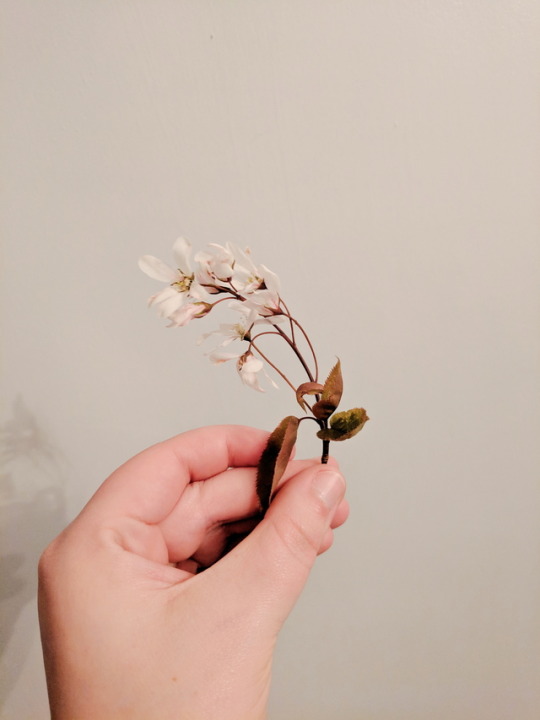
Just harvested a few small blooms of Amelanchier canadensis, sometimes called Canadian Serviceberry or simply Sugar Plum!
I really love the rich brown color of the leaves on this delicate spring flower. It's one of the first showy flowered trees to bloom in the spring around here, marking the start of the blooming season of spring.
101 notes
·
View notes
Text
Day 6 - Now I’ve Seen Flat
Today marked the longest driving day we have had so far, covering about 530 miles (850 km). We got up early and did a quick drive along the scenic loop within Dinosaur PP, took a peek at one of the two fossil displays, and revisited the viewpoint where we were almost blown over.

We then got on the road and started heading east again. I learned of the places where we planned our breaks/stops from Stuart McLean's Vinyl Café and by briefly stopping at these towns, while they were convenient stopping points, it was also a way of paying homage to this great Canadian storyteller who shared his love for Canada with his listeners for so many years.
Our first stop was Medicine Hat, AB. I found on BringFido.com that Kin Coulee Park has an off-leash area, so we thought it would be good to let Gimli run around a bit after being a bit cooped up for a couple of days - walking on leash does not make him "smile" like when he has his Chuck-it ball in his mouth and running through a park. And we were once again very impressed of the "off-leash park" which was actually a trail system within the park with river access (we didn't let him swim because we did not want a wet pup in the van!) that is "naturally enclosed" in the bandland area. Instead of fences, the steep walls of the gullies and ravines were enough to keep the dogs within bounds. There was even a large sign/art installation at the entrance of the off-leash area with a Lab that looked just like the Gimster! It was as if they have been expecting him all along!
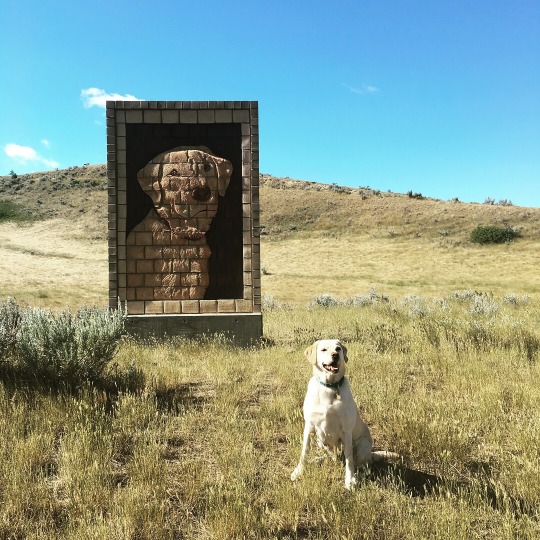
After a quick romp in the park, we got back on the road and headed to Swift Current, SK. The landscape along Trans Canada continued to change from the big sky country with prairies/pastures on gentle rolling terrain to super flat grasslands/canola/wheat fields. For the most part, there were not many trees, but in areas where there were wetlands/man-made ponds (?) or a stream, there are mostly poplar trees along the edge of the water; some farms also have evergreen trees planted as windbreaks. You can see for miles and miles in all direction and it was a pretty strange sensation for someone who has spent all her life living in hilly areas near the either the ocean or a lake. In Swift Current, we had a picnic lunch at the Memorial Park in the middle of town and quickly got back on the road.


Dan has been doing all the driving up until this point and it was my turn to be in the driver's seat for a little bit so that he could take a break. I drove us to Moose Jaw and because it was all highway driving, it was not as nerve-wrecking as it would have been if I were driving something so long in the city! We stopped for grocery at Moose Jaw and were off again.
We arrived at Fieldstone RV and Campground in Moosomin, SK, just after 7 PM. It is quite a large private campground that has probably been around for decades - it definitely has a summer camp feel to it. The campground is nestled in a wooded area and it is not too full, so our site is actually quite private.
We took a walk to stretch after the long day and I was pleasantly surprised by how many plants I recognized. The bugs were out in droves, so I didn't really have much time to geek out too much and ID those plants that interested me. I did spot quite a few (aptly named) Saskatoon berries - they are called serviceberries in the US - and it was like seeing an old friend in a new place!


Tomorrow will be another long-ish driving day… and we will be going to Gimli, MB! Super excited about bringing Gimli to the town after which he was named! But for now, good night from Moosomin, SK.
Check out our route on Roadtrippers!
#hymeraktiv#crosscontinentalroadtrip#roadtrip2018#campervan#bilbothevan#thereandbackagain#canadianprairies#labradorable#labradorsmile
0 notes
